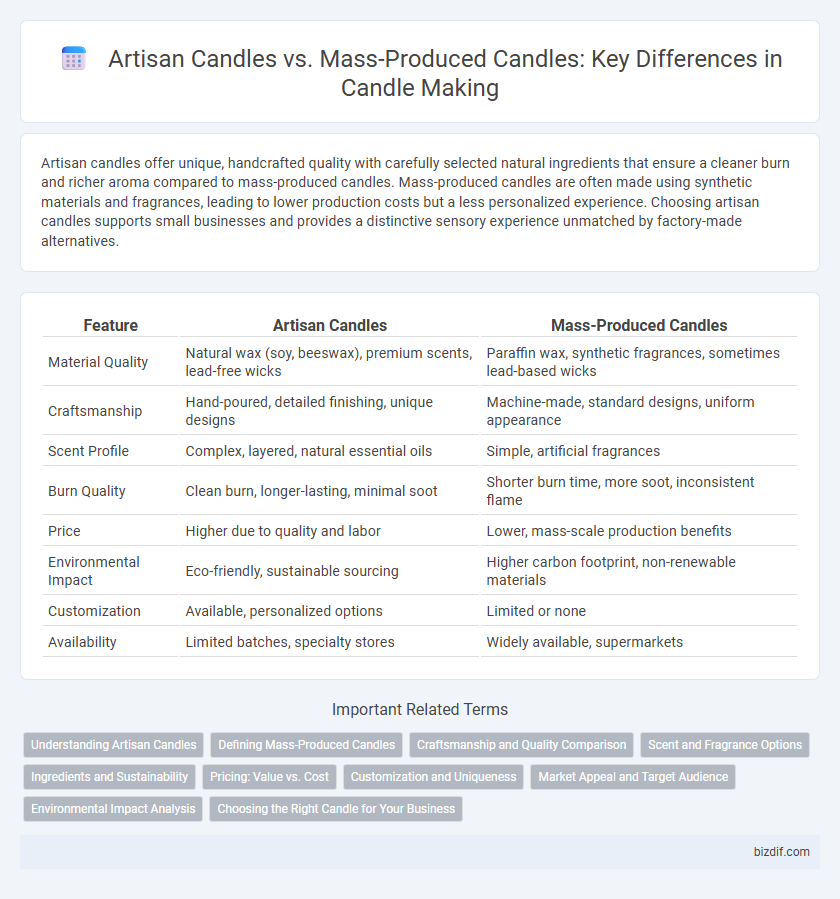Artisan candles offer unique, handcrafted quality with carefully selected natural ingredients that ensure a cleaner burn and richer aroma compared to mass-produced candles. Mass-produced candles are often made using synthetic materials and fragrances, leading to lower production costs but a less personalized experience. Choosing artisan candles supports small businesses and provides a distinctive sensory experience unmatched by factory-made alternatives.
Table of Comparison
| Feature | Artisan Candles | Mass-Produced Candles |
|---|---|---|
| Material Quality | Natural wax (soy, beeswax), premium scents, lead-free wicks | Paraffin wax, synthetic fragrances, sometimes lead-based wicks |
| Craftsmanship | Hand-poured, detailed finishing, unique designs | Machine-made, standard designs, uniform appearance |
| Scent Profile | Complex, layered, natural essential oils | Simple, artificial fragrances |
| Burn Quality | Clean burn, longer-lasting, minimal soot | Shorter burn time, more soot, inconsistent flame |
| Price | Higher due to quality and labor | Lower, mass-scale production benefits |
| Environmental Impact | Eco-friendly, sustainable sourcing | Higher carbon footprint, non-renewable materials |
| Customization | Available, personalized options | Limited or none |
| Availability | Limited batches, specialty stores | Widely available, supermarkets |
Understanding Artisan Candles
Artisan candles are crafted with high-quality, natural ingredients such as soy wax, beeswax, and essential oils, providing a cleaner burn and richer scents compared to mass-produced candles made with paraffin wax and synthetic fragrances. Each artisan candle is hand-poured, ensuring unique designs and meticulous attention to detail that enhances the aesthetic and sensory experience. Supporting artisan candle makers promotes sustainable practices and preserves traditional craftsmanship, resulting in a superior product that often lasts longer and performs better.
Defining Mass-Produced Candles
Mass-produced candles are manufactured in large quantities using automated processes, often prioritizing cost-efficiency over unique design or high-quality ingredients. These candles typically utilize paraffin wax, synthetic fragrances, and standard wicks to ensure uniformity and extended shelf life. The production emphasizes consistency and affordability, resulting in less customization and lower artisanal value compared to handmade candles.
Craftsmanship and Quality Comparison
Artisan candles showcase superior craftsmanship through hand-poured techniques and high-quality, natural ingredients like beeswax and soy, ensuring clean, long-lasting burns with rich, unique scents. Mass-produced candles often rely on cheaper paraffin wax and synthetic fragrances, resulting in uneven burns and stronger, less nuanced aromas. The meticulous attention to detail in artisan candles elevates their aesthetic appeal and overall performance compared to factory-made alternatives.
Scent and Fragrance Options
Artisan candles offer a diverse range of unique, high-quality scents crafted from natural essential oils and carefully blended fragrance oils, providing a more complex and authentic aroma experience. Mass-produced candles often rely on synthetic fragrances with limited scent options, which can result in a less nuanced and sometimes overpowering smell. Consumers seeking personalized and sophisticated fragrance profiles typically prefer artisan candles for their distinct and lasting scent appeal.
Ingredients and Sustainability
Artisan candles often use natural ingredients such as soy wax, beeswax, and essential oils, ensuring higher quality and eco-friendliness compared to mass-produced candles that frequently contain paraffin wax and synthetic fragrances. These handcrafted candles emphasize sustainable sourcing and biodegradable materials, reducing environmental impact. In contrast, mass-produced candles rely on cost-effective, petroleum-based components that contribute to pollution and waste.
Pricing: Value vs. Cost
Artisan candles typically command higher prices due to handcrafted quality, unique scents, and sustainable materials, offering greater value to consumers seeking exclusivity and durability. Mass-produced candles are priced lower, reflecting economies of scale and simplified production processes, making them more affordable but often lacking in personalized appeal. The cost difference represents a trade-off between raw expense and perceived long-term worth.
Customization and Uniqueness
Artisan candles offer unparalleled customization with handcrafted designs, unique scents, and high-quality natural ingredients tailored to individual preferences. Mass-produced candles often rely on standardized formulations and repetitive manufacturing processes, resulting in uniformity but limited variety. The distinctiveness of artisan candles appeals to consumers seeking personalized, exclusive products that reflect creativity and craftsmanship.
Market Appeal and Target Audience
Artisan candles appeal to niche markets seeking unique, handcrafted scents and eco-friendly materials, attracting customers willing to pay premium prices for quality and craftsmanship. Mass-produced candles target broader audiences with affordable prices and consistent product availability, catering to mainstream demand and large retail distribution. The artisan segment emphasizes exclusivity and brand storytelling, while mass production relies on scalability and standardized branding to maximize market reach.
Environmental Impact Analysis
Artisan candles often utilize natural, biodegradable materials such as soy wax, beeswax, and essential oils, resulting in a lower environmental footprint compared to mass-produced candles that frequently contain paraffin wax derived from petroleum. The small-batch production of artisan candles reduces energy consumption and waste generation, while mass production relies on industrial processes with higher carbon emissions and plastic packaging. An environmental impact analysis reveals that artisan candles support sustainable sourcing practices and minimize harmful pollutants, making them a more eco-friendly choice in candle making.
Choosing the Right Candle for Your Business
Artisan candles offer unique scents, handcrafted quality, and customizable designs, making them ideal for boutique businesses seeking to create a distinct brand identity. Mass-produced candles provide cost efficiency and consistent availability, suitable for large retail operations with high volume demands. Selecting the right candle involves balancing quality, price, and target market preferences to maximize customer satisfaction and business growth.
Artisan candles vs Mass-produced candles Infographic

 bizdif.com
bizdif.com